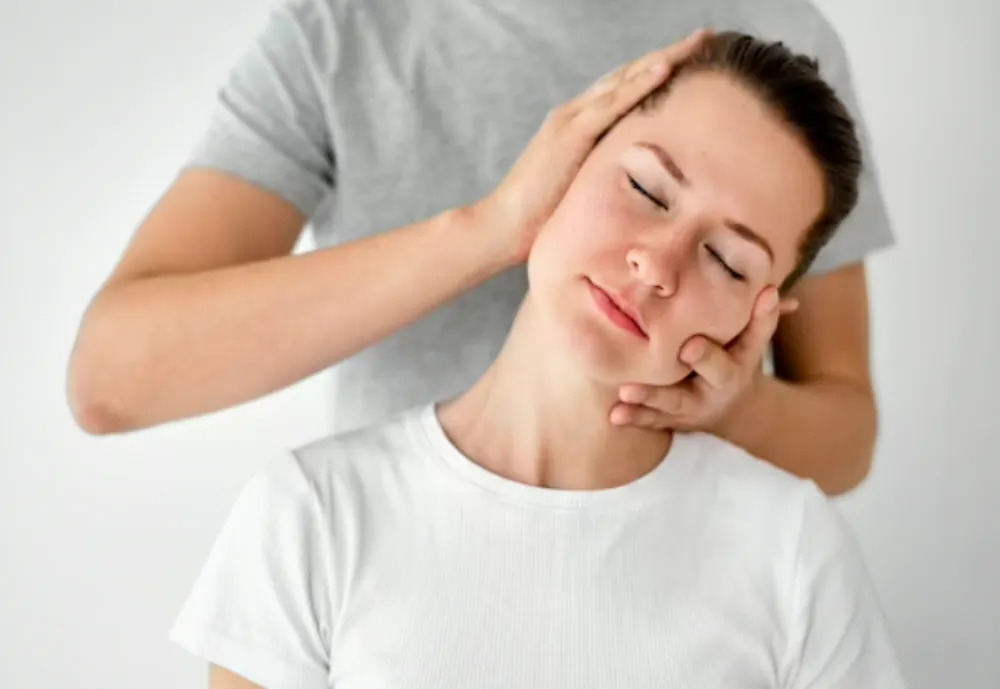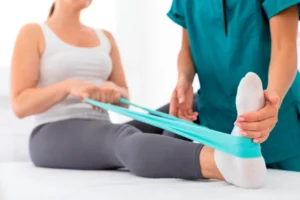- The mandible
- The articular disc
- The temporal bone
- The muscles or ligaments of the jaw
- Other nearby structures such as the neck, ears, teeth, face and cervical spine.
Symptoms Of TMD
- Clicking or popping noises from the jaw
- Teeth grinding/clenching
- Limited movement of the jaw
- Jaw tenderness
- Ear pain
- Headaches
- Upper neck pain
What Are The Causes Of TMJ Disorders?
A few causes of TMJ, a multifaceted musculoskeletal disorder may include:
- Abscessed tooth – Pus around a tooth that’s caused by a bacterial infection which can spread from the tooth’s root to surrounding bone and tissues, causing jaw or facial pain.
- Arthritis – Jaw joints may become inflamed or begin to break down and cause jaw pain.
- Gum (periodontal) disease – An infection in your gum caused by poor dental care may cause jaw pain.
- Trauma – A broken or dislocated jaw is a medical emergency that requires immediate treatment.
- Bruxism (grinding teeth) — can affect people of all ages. It can damage teeth and cause jaw pain because teeth grinding can often apply too much pressure. The actions can cause damage and uneven wear to the surface of the teeth, which then causes uneven pressure on the joints of the jawbones.
- Osteomyelitis – It is an infection that travels through the body’s bloodstream affecting an individual’s bones and surrounding tissues. It can cause pain in the cheekbones and jaw leading to fever or swelling.
- Sinus problems.
- Myofascial pain syndrome – This is where “trigger points” small areas of very tight, contracted muscle tissue cause pain
- Simple overuse of the chewing muscles : Anyone with the constant habit of chewing gum may find themselves with jaw pain
TMD usually affects:
- Women – 30 – 50 years.
- Sitting with poor posture with your head forward: Such as when looking at a computer screen all day, is sometimes associated with TMJ pain.
TMJ opening disorders may include:
- Arthritis or stiffness
- TMJ hyper-mobility
- Muscle disorder
- TMJ disc displacement
- Cervical spine issue
TMJ closing disorders can involve:
- Locked joint
- Occlusion problems
Physiotherapy for TMJ pain may involve an assessment to evaluate your muscle length and tension, jaw range of motion and your TMJ movement patterns. The physical therapist tries to ascertain your temporomandibular joints disorder to know whether there is a problem associated with opening or closing of the jaw.

Finding an experienced TMJ physiotherapist can help reduce symptoms and alleviate the pain and joint restriction (restricted mouth opening) that is the most common symptom of this condition. Equally important is learning how to prevent recurrence, a core tenant of the physiotherapist’s approach to treating TMJ dysfunction.
Physiotherapists can aid in jaw pain by improving motion of the affected area. Exercises include relaxed jaw exercises, opening and closing the mouth, resisting mouth opening and closing, moving the jaw from side to side, tongue up and many more can be used to help improve strength and reduce pain. However the course of treatment will be person specific and depends on the severity of the symptoms.

Jaw pain can also be alleviated by simply correcting posture and alignment. Physical therapy can help align any postural or other causes which result in distrainment that may lead to TMD. Using physical therapy, the therapists can educate patients on proper jaw positioning to prevent further injury and deterioration of the condition. This may include education on proper chewing techniques, avoiding grinding of the teeth in a relaxed position, and using several techniques to reduce stress.
Functional Manual Therapy®️ (FMT™️) @ VARDĀN, can provide an effective way to manage jaw pain and improve quality of life for those suffering from TMD. By recommending personalised exercises to reduce pain and inflammation, improving range of motion, strengthening muscles, correcting posture and alignment, and providing education, our functional manual therapists can help us reduce any discomfort and restore normalcy to the affected area. If you are experiencing jaw pain, it is important to seek the advice at the earliest for faster recovery through a personalised and supervised treatment plan.
To know more about (FMT™️) call us at :+91 011 43580720-22.




